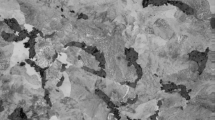Abstract
A smooth polished surface has a great potential to lead to low friction and wear in internal combustion engines (ICE). Alternative methods to create a smooth dimpled surface on a hypereutectic aluminium (aluminium die cast) ADC12 substrate for frictional improvements are evaluated in this study using an oscillating wear tester (OWT). It was found that the samples embossed with #480 grit sandpaper and sandblasted with #240 sieve sand samples had the more desired properties with a reduced coefficient of friction (μ) of 23% at low sliding speeds before hydrodynamic lubrication mode and 6.9% in the fully hydrodynamic lubrication region. Although samples cast with added graphite powder had much lower friction, it had insufficient oil retention volume and resistance against catastrophic wear.





















Similar content being viewed by others
References
Kaufman JG (2000) Introduction to aluminum alloys and tempers. ASM International, Geauga
Plotkowski AJ (2012) Refinement of the cast microstructure of hypereutectic aluminum-silicon alloys with an applied electric potential. Master thesis, Grand Valley State University
Yasmin T, Khalid AA, Haque M (2004) Tribological (wear) properties of aluminum–silicon eutectic base alloy under dry sliding condition. J Mater Process Technol 153:833–838
ZolotorevskyVS Belov NA, Glazoff MV (2010) Casting aluminum alloys. Elsevier, Amsterdam
Warmuzek M (2004) Aluminum-silicon casting alloys: an atlas of microfractographs. ASM International, Geauga
Olsson H et al (1998) Friction models and friction compensation. Eur J Control 4(3):176–195
Persson B (2013) Sliding friction: physical principles and applications. Springer Science & Business Media, Berlin
Xia X et al (2008) Tribological performance of an Al—Si alloy lubricated in the boundary regime with zinc dialkyldithiophosphate and molybdenum dithiocarbamate additives. Proc Inst Mech Eng Part J J Eng Tribol 222(3):305–314
Suzuki Y (1988) Surface modifications of pistons and cylinder liners. J Mater Eng 10(1):61–67
León FP (2002) Evaluation of honed cylinder bores. CIRP Ann Manuf Technol 51(1):503–506
Malburg MC, Raja J, Whitehouse DJ (1993) Characterization of surface texture generated by plateau honing process. CIRP Ann Manuf Technol 42(1):637–639
He X et al (2015) Tribological behavior of femtosecond laser textured surfaces of 20CrNiMo/beryllium bronze tribo-pairs. Ind Lubr Tribol 67(6):630–638
Armstrong-Helouvry B (2012) Control of machines with friction, vol 128. Springer Science & Business Media, Berlin
Hermann S and Ruggeri F (2016) Modelling wear degradation in cylinder liners. Discussion Paper, SonderForschungSbereich (SFB) 823:433
Howell-Smith S et al (2014) Reducing in-cylinder parasitic losses through surface modification and coating. Proc Inst Mech Eng Part D J Automob Eng 228:0954407013512626
Brinksmeier E (2013) Tool making. micro metal forming. Springer, Berlin, pp 201–310
Ortner H et al (2002) Corrosion of transversely heated graphite tubes by iron and lanthanum matrices. Spectrochim Acta Part B 57(2):243–260
Lu H et al (2005) Effect of surface roughness on stain resistance of dental resin composites. J Esthet Restor Dent 17(2):102–108
Smith GT (2008) Cutting tool technology: industrial handbook. Springer Science & Business Media, Berlin
Singh G (2013) Modeling, analysis, evaluation and experimental investigation of abrasive blasting process. Thapar University Patiala, Patiala
Martin SJ et al (1993) Effect of surface roughness on the response of thickness-shear mode resonators in liquids. Anal Chem 65(20):2910–2922
Iqbal M (2014) Tribology: science of lubrication to reduce friction and wear. Int J Mech Eng Robot Res 3(3):648
Bennett J, Dancy J (1981) Stylus profiling instrument for measuring statistical properties of smooth optical surfaces. Appl Opt 20(10):1785–1802
Braaksma H et al (2006) Sedimentological, petrophysical, and seismic characterization of an Upper Jurassic shoreface-dominated shelf margin (the Boulonnais, northern France). J Sediment Res 76(1):175–199
Elfick APD (1999) A tribological assessment of the porous coated anatomic total hip replacement. Durham University, Durham
Stewart JH, Briggs GM (1981) The effect of essential-fatty-acid deficiency on the activity of liver phosphatidate phosphatase in rats. Biochem J 198(2):413
Akhlaghi F, Zare-Bidaki A (2009) Influence of graphite content on the dry sliding and oil impregnated sliding wear behavior of Al 2024–graphite composites produced by in situ powder metallurgy method. Wear 266(1):37–45
Cremaschi L, Hwang Y, Radermacher R (2005) Experimental investigation of oil retention in air conditioning systems. Int J Refrig 28(7):1018–1028
Findik F (2014) Latest progress on tribological properties of industrial materials. Mater Des 57:218–244
Ho C-M, Tai Y-C (1998) Micro-electro-mechanical-systems (MEMS) and fluid flows. Annu Rev Fluid Mech 30(1):579–612
Cogdell JD (2008) A convolved multi-Gaussian probability distribution for surface topography applications. Precis Eng 32(1):34–46
Checo HM et al (2014) Moving textures: simulation of a ring sliding on a textured liner. Tribol Int 72:131–142
Gahr KHZ, Mathieu M, Brylka B (2007) Friction control by surface engineering of ceramic sliding pairs in water. Wear 263:920–929
Costa H, Hutchings I (2007) Hydrodynamic lubrication of textured steel surfaces under reciprocating sliding conditions. Tribol Int 40(8):1227–1238
Dobrica MB et al (2010) Optimizing surface texture for hydrodynamic lubricated contacts using a mass-conserving numerical approach. Proc Inst Mech Eng Part J J Eng Tribol 224(8):737–750
Kovalchenko A et al (2004) The effect of laser texturing of steel surfaces and speed-load parameters on the transition of lubrication regime from boundary to hydrodynamic. Tribol Trans 47(2):299–307
Griffiths B (2001) Manufacturing surface technology: surface integrity and functional performance. Elsevier, Amsterdam
Acknowledgements
The authors would like to express their deep gratitude to Universiti Malaysia Pahang (UMP) under RDU160319 and Nelson Mandela Metropolitan University for providing the laboratory facilities and financial support.
Author information
Authors and Affiliations
Corresponding author
Additional information
Technical Editor: Márcio Bacci da Silva.
Rights and permissions
About this article
Cite this article
Kadirgama, K., Ramasamy, D., El-Hossein, K.A. et al. Assessment of alternative methods of preparing internal combustion engine cylinder bore surfaces for frictional improvement. J Braz. Soc. Mech. Sci. Eng. 39, 3591–3605 (2017). https://doi.org/10.1007/s40430-017-0789-6
Received:
Accepted:
Published:
Issue Date:
DOI: https://doi.org/10.1007/s40430-017-0789-6




